UPDATE JUNE 16, 2011: I've updated this review to include a Novatac Storm and second Classic sample.
This isn't going to be a full review, but a quick comparison of the Novatac "Classic" (2xAA 120 lumens) and "Storm" (1xCR123A 120 lumens) - both currently on close-out at a number of vendors - to the true classic, the Novatac 120P (1xCR123A/RCR).
Novatac Classic (in gun metal gray finish) vs Novatac 120P (in pewter finish):
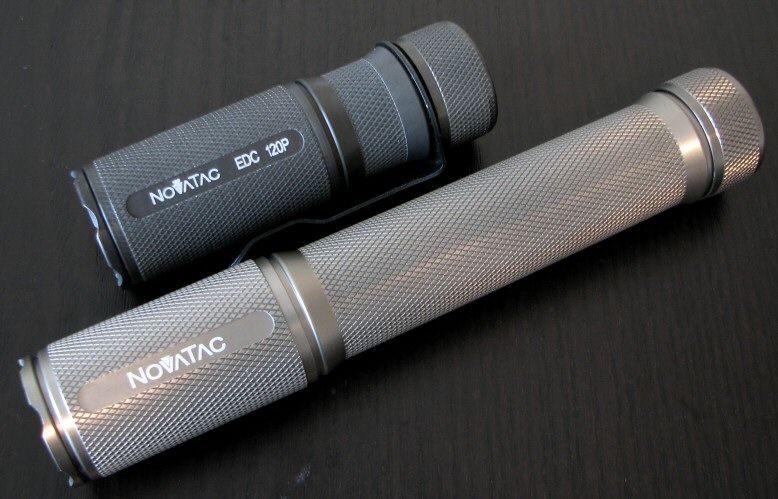
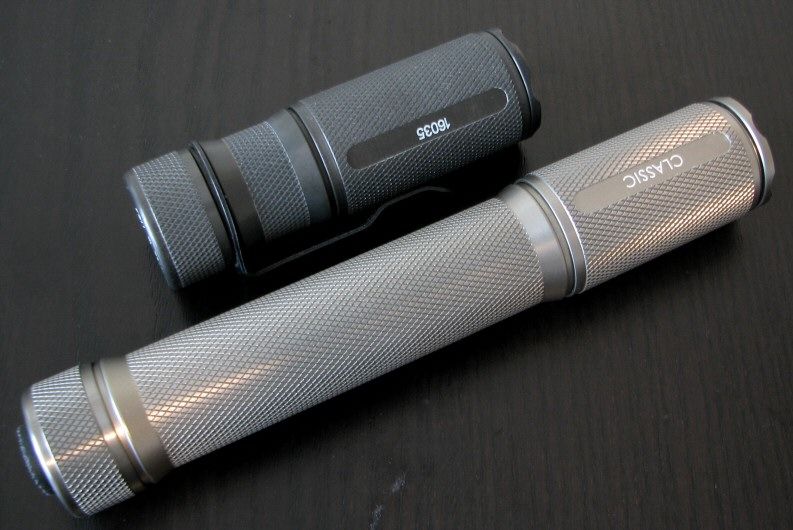
And now the Novatac Storm, in black finish:
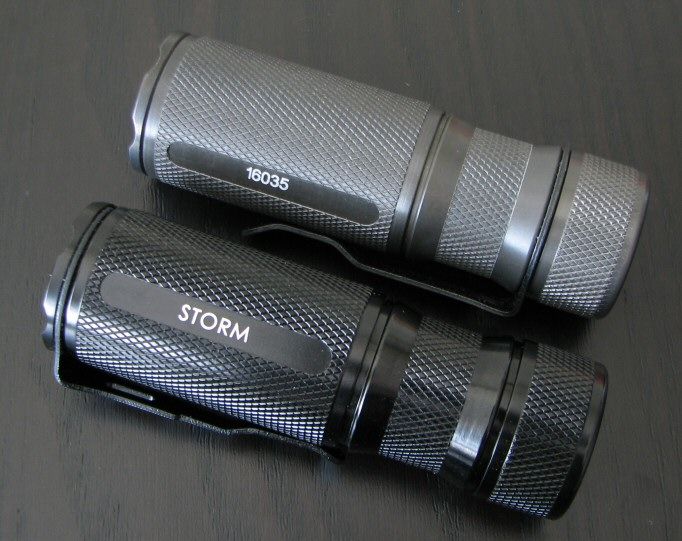
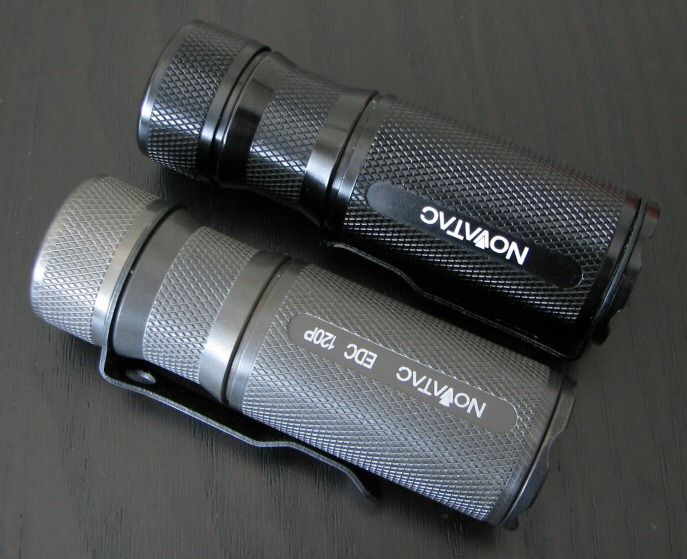
For all Classic comparisons, the 120P will be shown first (or on the left) followed by the Classic. Note that my 120P sample dates from early 2008.
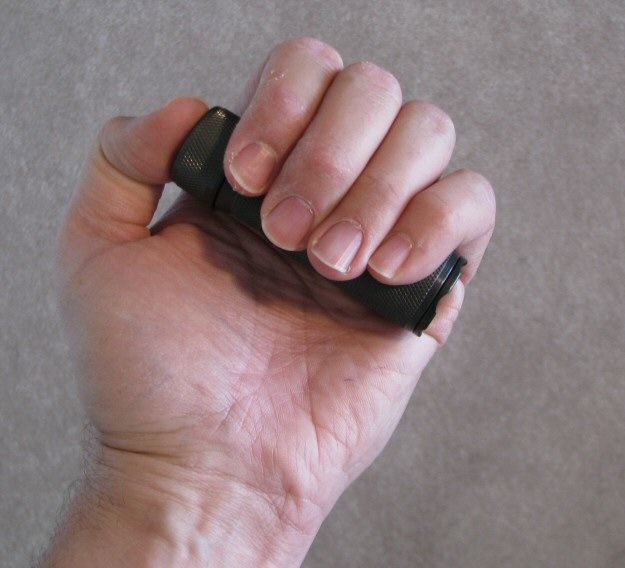
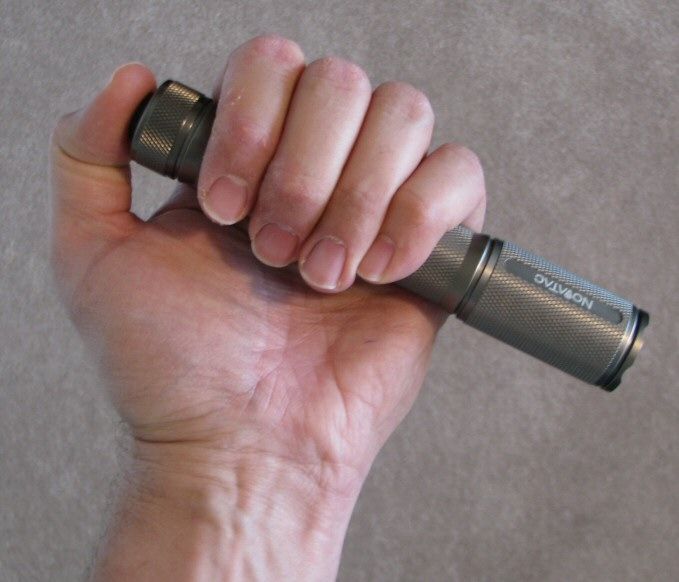
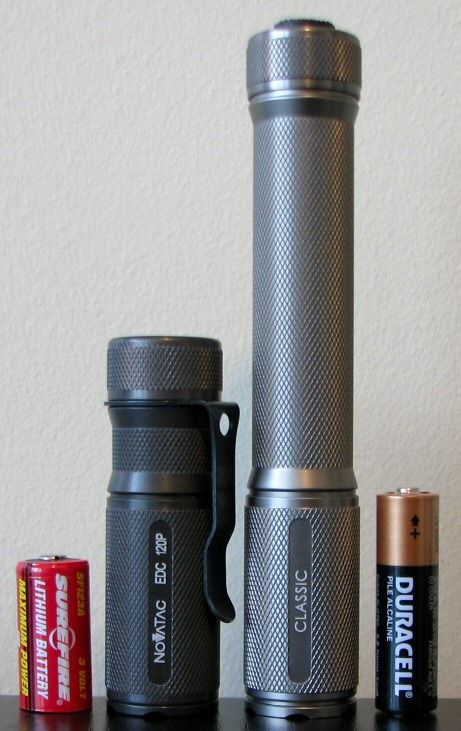
From left to right: CR123A, Novatac 120P, Novatac Classic, Duracell alkaline
Novatac Classic & Storm specifications:
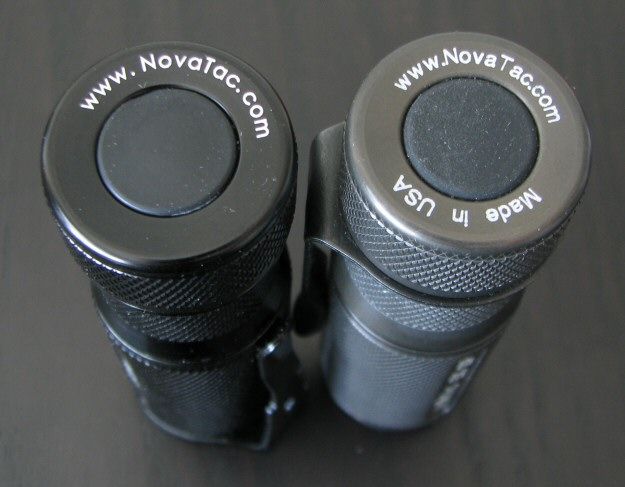
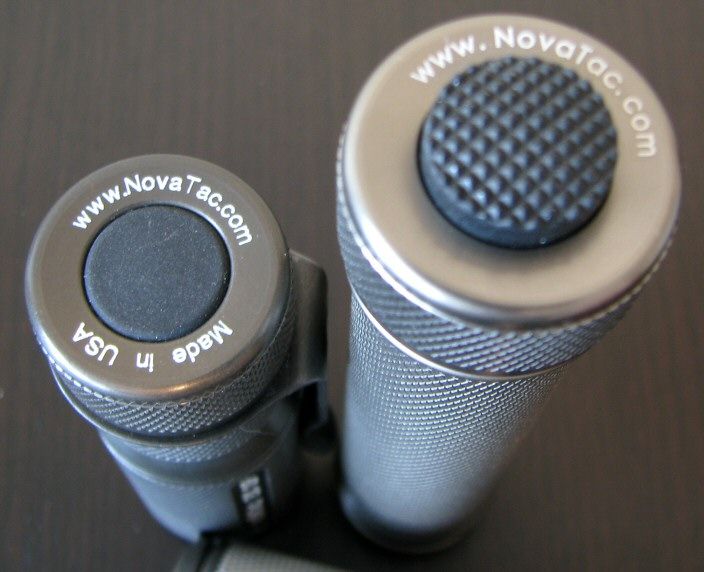
Tailcaps look the same on 120P and Storm (except that the Made in USA label is gone, of course). Feel has certainly changed though - my Storm's switch feels a lot more "squishy". :shrug: The Classic uses a protruding clicky, which has a better feel in my opinion.
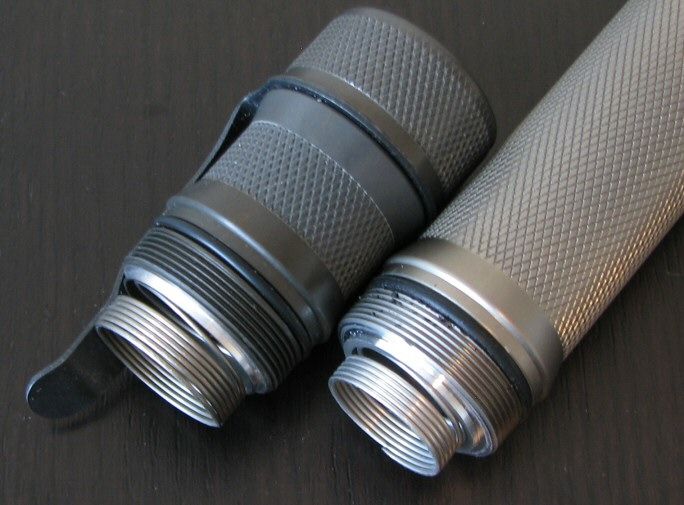
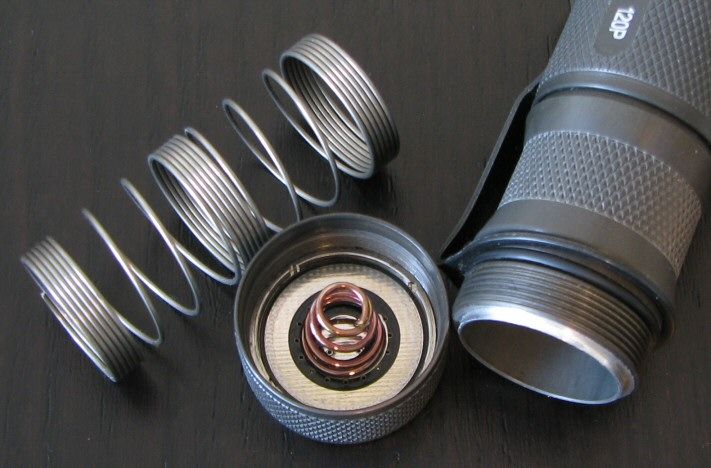
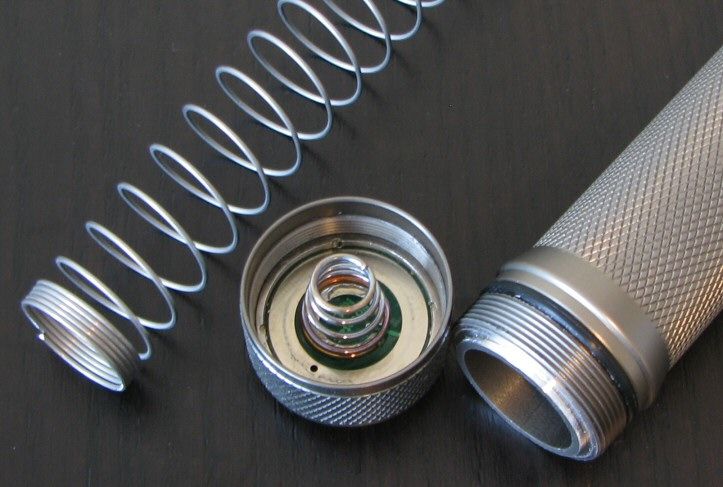
The obvious external changes are in the bezel (now aluminum instead of stainless steel, with a clip attachment point), anodizing (now just type II, not hard anodized any more) and the actual clip (the Classic doesn't come with one, but the Storm and Special Ops versions do - and it differs from before). Choice of anodizing color has also changed - my 120P is in pewter finish and the Classic shown above is supposedly "gun metal gray". My Novatac Storm sample is in black.
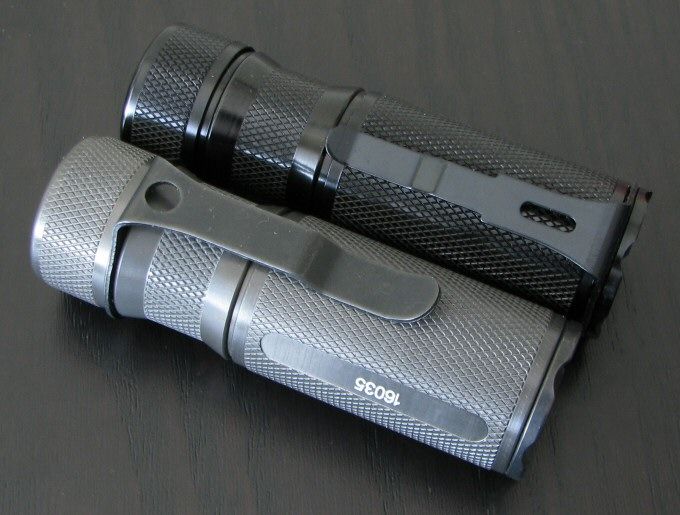
First the clip - on the Storm, it no longer securely fits around the whole light at the tail, but clips on at the bezel. In real life, it feels a lot more flimsy now. :sigh:
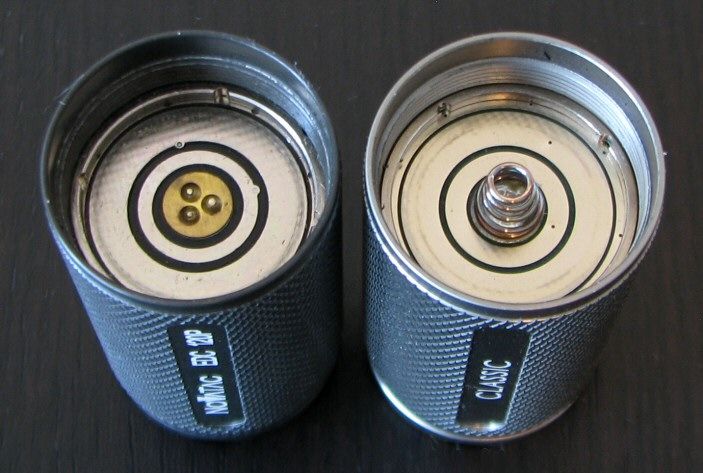
Inside, you can see the addition of the spring on the positive contact in the head. Note that this actually occurred during the 120P's production run (ca 2009) - my 120P sample dates from before this change (2008).
 Be careful here - there are lots of reports of this spring getting bent/damaged if you screw/unscrew the head from the battery compartment with cells inside. It seems the early version Storm/Classic lights had soft springs in the head, that deformed and bent easily. All three recent samples in my possession (from the recent closeout offers) seem pretty good - the springs are nice and firm. Still, best to always load your cells from the tailcap end now.
Be careful here - there are lots of reports of this spring getting bent/damaged if you screw/unscrew the head from the battery compartment with cells inside. It seems the early version Storm/Classic lights had soft springs in the head, that deformed and bent easily. All three recent samples in my possession (from the recent closeout offers) seem pretty good - the springs are nice and firm. Still, best to always load your cells from the tailcap end now.
On the whole, I find these newer Classic and Storm lights to have lower quality "hand feel". This is especially noticeable with the machining and knurling (which was never aggressive to start with, but seems even less so now). The anodizing is not as thick, and while the gun metal finish looks ok, I find the black finish looks shiny and rather cheap. The cut-outs for the labels on the head are quite sharp edged (i.e. I could imagine someone cutting themselves on mine - which is ironic given the otherwise slippery feel). Overall, you definitely get the impression that these new lights are not in the same build class as the earlier Novatacs. :sigh:
The Classic doesn't come with a clip (and the Storm's version doesn't inspire a lot of confidence), so I recommend you pick up one of the original 85/120-series era clips as an accessory. Size should fit fine - and they make useful anti-roll devices. Alternatively, something like one of the 4Sevens rubber finger grips for the Quark CR123A also works well on the Storm.
The lights have a standard 1-inch opening at the bezel, so any of the common 1-inch diffusers/filter covers will fit. :thumbsup:
One of my main reasons for picking up the Classic was to see if the 2xAA body tube would fit and work on my 120P. :devil: But I was also curious to see if the Classic and Storm used a similar circuit to the 120P.
On the first front, I can happily report that all the parts were completely interchangeable between my 2008-version 120P and recent Classic/Storm purchases. I can now use either tailcap or body tube on either head, of any model. :twothumbs
On the second front (i.e. circuit), things get a little more interesting. More on that in a moment ...
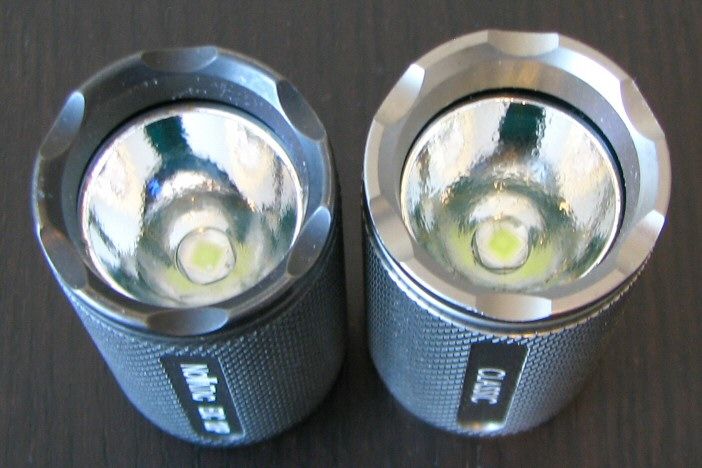
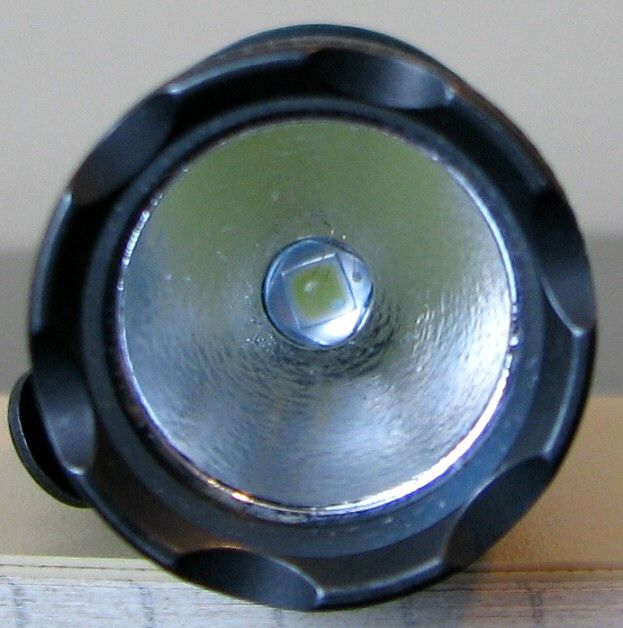
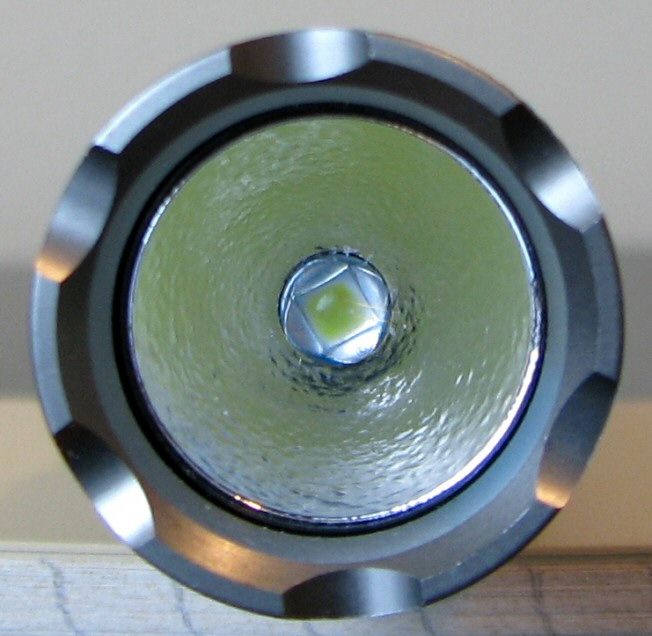
The heads look relative similar from the front. The reflector seems slightly more heavily textured on the Classic/Storm, but the difference isn't huge. I expect similar beam profiles.
Which brings me to the white-wall beamshots. 120P is on 1xAW protected RCR, Classic on 2xEneloop, about ~0.75 meter from a white wall (with the camera ~1.25 meters back from the wall). Automatic white balance on the camera, to minimize tint differences.
120P is on 1xAW protected RCR, Classic on 2xEneloop, about ~0.75 meter from a white wall (with the camera ~1.25 meters back from the wall). Automatic white balance on the camera, to minimize tint differences.
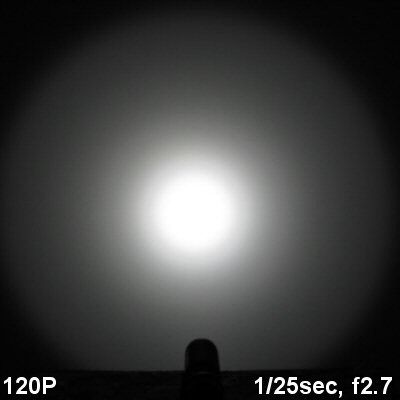
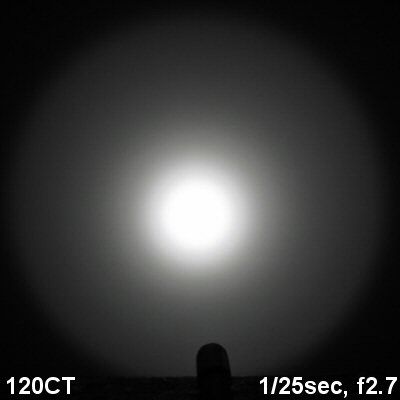
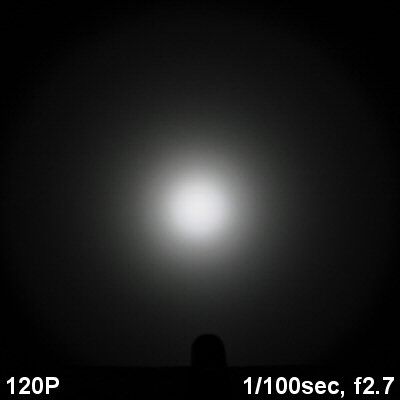
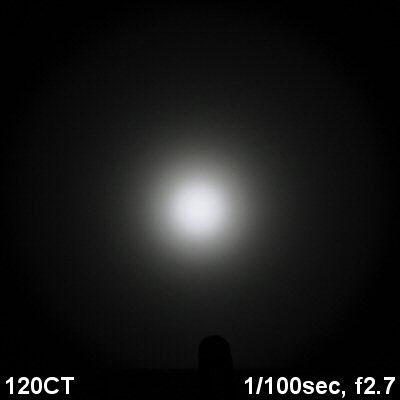
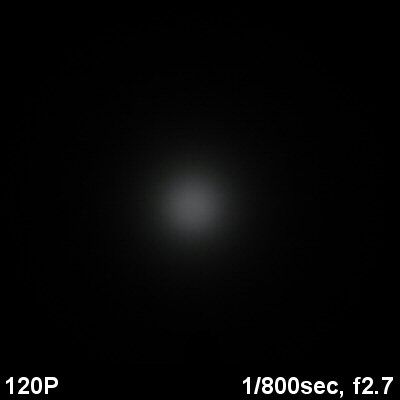
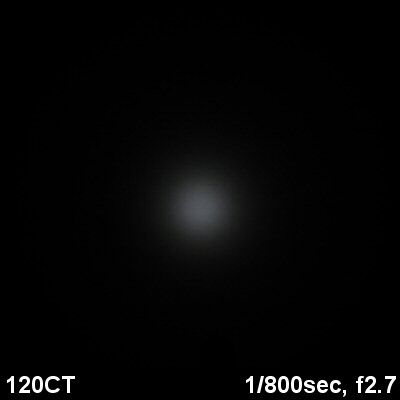
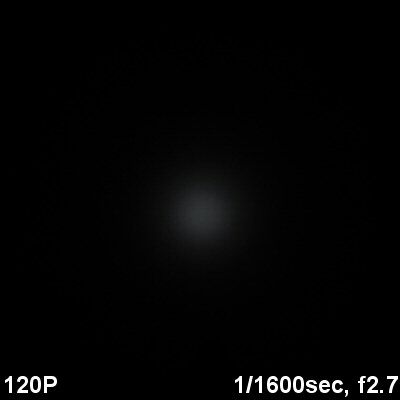
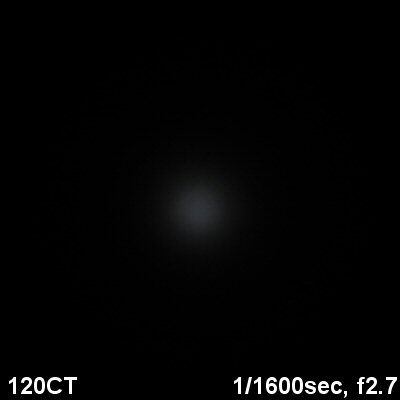
The beams don't look all that different, but the Classic seems to be a little more narrowly focused (i.e the hotspot is slightly more defined). Tint-wise, my 120P was somewhat creamy yellow-white, whereas both my Classic and Storm samples have a definite blue tone. :shrug:
User Interface
I am not going to go through all the UI differences between the various Novatac models - largely because they don't matter! As has long been reported here, there is a backdoor crack that lets you turn any model into the fully programmable 120P (thank you LLCoolBeams :bow .
.
As you will see in that thread, users report that both the Storm and the Classic version can be cracked to a fully programmable version using the 250-click trick. But does it work properly if you do? I was a little concerned on this front, since according to Novatac's specs, the 2xAA Classic has a different voltage range (1.8V-3.5) from the 1xCR123A/RCR Storm (2.0-4.2V), both of which are narrower than the earlier 120-series lights (1.8V-4.5V). It thus seems that they have customized the circuits of the current models.
I will have more to say about this after the runtimes, but my Classic/Storm and 120P do behave somewhat differently on various batteries. And I can confirm that the 250-click crack worked to unlock the programming modes of my Classic and Storm. :twothumbs
Testing Method:
All my output numbers are relative for my home-made light box setup, a la Quickbeam's flashlightreviews.com method. You can directly compare all my relative output values from different reviews - i.e. an output value of "10" in one graph is the same as "10" in another. All runtimes are done under a cooling fan, except for any extended run Lo/Min modes (i.e. >12 hours) which are done without cooling.
I have recently devised a method for converting my lightbox relative output values (ROV) to estimated Lumens. See my How to convert Selfbuilt's Lighbox values to Lumens thread for more info.
Effective November 2010, I have revised my summary tables to match with the current ANSI FL-1 standard for flashlight testing. Please see http://www.sliderule.ca/FL1.htm for a description of the terms used in these tables.
Throw/Output Summary Chart:
NOTE: One of the characteristics of the Novatac lights is that output gradually rises over the first stage of regulated output (and continuously fluctuates slightly during that time). This makes it hard to ascribe specific lumen estimates (i.e. do I pick the start, the middle, or the end?). Rather than stick with my ANSI FL-1 standard of 3 mins, in the tables below I give the min and max range of lumens estimates over the course of that first stage of output. Please see my actual runtime graphs for a visual depiction of what I am referring to here.

Thanks to ability to mix and match heads/bodies, I am able to test all four lights on both 2xEneloop and 1xCR123A.
First off, you will note a fair amount of variability - although my original 120P's lumen estimates are pretty consistent with the rated spec, my two Classic samples vary by ~15-20% above (sample #2) or below (sample #1) my original 120P. :shrug: My Storm sample was in-between my two Classic samples, and just slightly less than my original 120P.
In terms of throw, there doesn't seem to be much a difference in the optics between the lights - lux @ 1m basically correlates with output levels across these lights.
Note that I have left the stock shipping Lo mode values in the table above. If you perform the backdoor programming hack on the Classic or Storm, you can access all the programming menus - allowing you to go as low as 0.08 estimated lumens if you wish (i.e. same as 120P). There isn't much noticeable variation at the low end of outputs, between the models.
Output/Runtime Comparison:
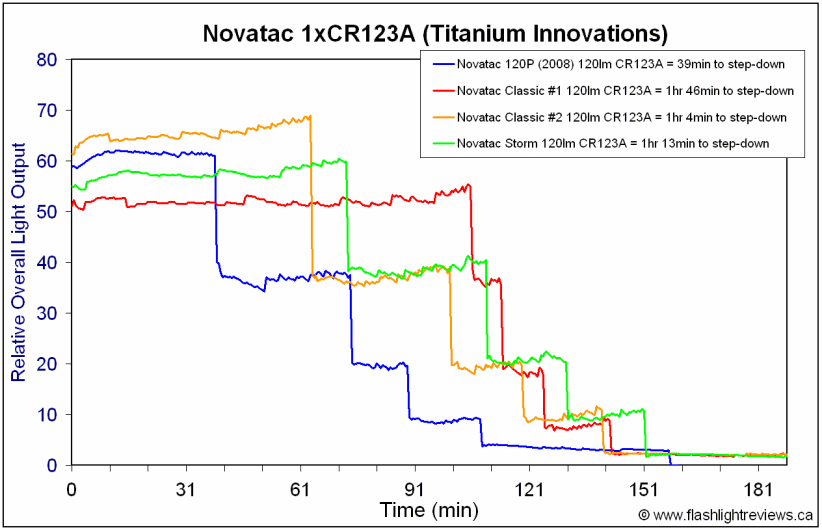
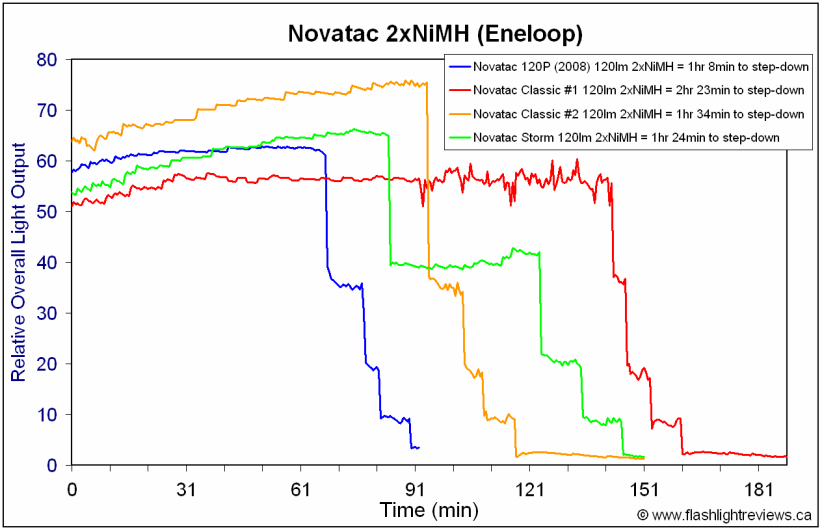
Scales are identical above, to facilitate comparisons between the graphs. Note that I did a battery reset before each test above, so the light is appropriately set.
One of the first things you are likely to notice is that these lights all run longer on 2xEneloop than 1xCR123A (at least, longer before step-down occurs). Interestingly, the two Classic samples show a much greater improvement than the Storm (which only shows a moderate increase when going to 2xEneloop). This leads me to suspect the Classic circuit is indeed optimize for low voltage battery sources.
More subtle in the graphs is that these newer lights are slightly brighter on 2xEneloop than 1xCR123A (compare each individual head's relative performance across batteries). In contrast, my 120P was pretty consistent on both battery sources. This again supports the idea that something has changed more generally on the new circuits.
Another point - the newer lights all run longer than my original 120P on Max before stepping down. This is likely due to changes in the emitter output bins over time. My 120P was purchased almost 3 years ago, so one can reasonably expect that Novatac has been using higher output bins more recently (i.e., more efficient ones).
Also, you will note that the runtime regulation patterns look as "messy" as ever. These small variations in regulation are not visible to the naked eye - the output seems perfectly constant in use, it is just the lightbox that can detect them. Although not shown here, I can tell you that modern HDS lights are far more consistent in maintaining very flat output regulation at every stage.
Oh, and wondering how these lights compare to others in the 2xAA class?
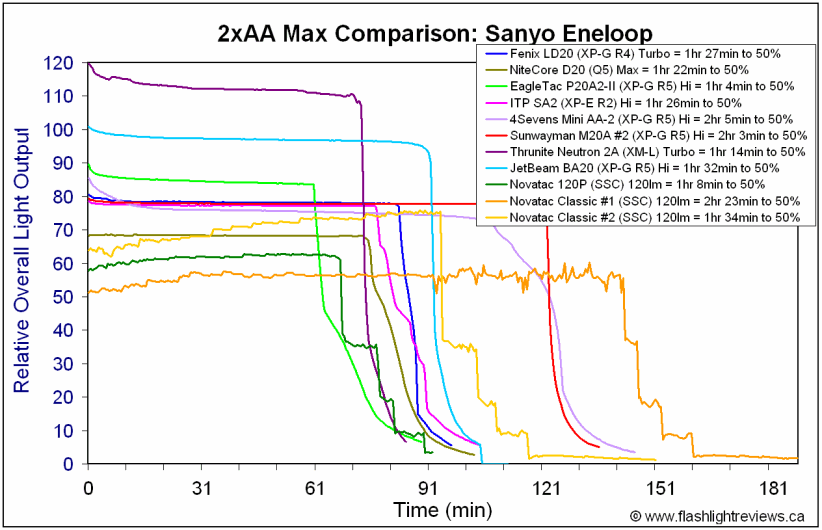
The 120 lumen output level is definitely at the lower end of the spectrum for modern lights, but it isn't that bad - typically around the level of XR-E Q5 light. And the overall efficiency of the Classics seem good for the output level (i.e. better than a Q5 2xAA light).
Preliminary Discussion
Build-wise, the Novatac Classic and Storm are definitely a more basic product than the earlier 120-series lights. Although most of the changes are subtle, build quality has decreased - the quality of machining and anodizing are the most immediately obvious. :sigh: Still, I am glad to see they have kept all the diameters and threading the same, allowing you to mix and match parts. And the runtime has definitely increased compared to my earlier 2008 model (as you would expect given the gains in emitter efficiency over time).
However, I should note that there are a lot more concerns here on CPF over the quality and reliability of these current Novatac models, compared to the earlier 120-series lights. Some of these issues may have been specific to the early production runs of the Storm/Classic series, and have since been improved (e.g. spring stiffness in the head). But it's clear that overall quality has dropped a notch from the earlier 120-series. Still (and knock on wood), to date I have had no significant problems with any of my recent three Classic/Storm samples.
But to put that in context, these are complex lights with a (potentially finicky) programmable interface. It is not hard to elicit flaky behavior from any Novatac light (including the venerable 120P), especially during battery changes. As I discovered long ago on my 120P, it's important to keep the threads and contact surfaces clean. Just a guess, but I suspect slight current interruptions during tailcap tightening can fool the circuit into thinking programming clicks have been entered, sometimes leading you down strange paths. As with all Novatac/HDS lights, soft resets are your friend If strange things happen after re-doing the tailcap, unscrew it again and wait ~30 secs before re-tightening, to see if the issue resolves itself.
If strange things happen after re-doing the tailcap, unscrew it again and wait ~30 secs before re-tightening, to see if the issue resolves itself.
At their original ~$110 list price, these current Novatac lights don't seem worth it, given the current competition. But with the various close-out prices at different vendors, the risk/benefit analysis becomes more attractive IMO. This is especially true since the backdoor programming hack works on all current models. :thumbsup: But you need to keep in the mind that that the Classic model has a more restricted voltage range than the earlier 120-series (i.e. I wouldn't recommend trying 1xRCR on a Classic head).
I realize that most people here may not be too interested in a rapidly discontinuing series, but I thought some might like the direct comparisons to the older 120P (and modern 2xAA lights). Of course, these Novatac lights in no way compete with the newer HDS/Ra line (which seem to have continued innovation in build, circuit, emitter and interface from the early HDS/Novatac progenitors). In some ways, Novatacs seem largely stuck in ~2009, but there are at least a few minor tweaks to the circuit (especially on the Classic). It's a pity that the build has seen some drops in quality, though. And there is also clearly some variability in max output across my samples.
but there are at least a few minor tweaks to the circuit (especially on the Classic). It's a pity that the build has seen some drops in quality, though. And there is also clearly some variability in max output across my samples.
Still, at these discount prices, the true comparison needs to be other lights in this price range. In that regard, I hope you find the comparisons useful. :wave:
This isn't going to be a full review, but a quick comparison of the Novatac "Classic" (2xAA 120 lumens) and "Storm" (1xCR123A 120 lumens) - both currently on close-out at a number of vendors - to the true classic, the Novatac 120P (1xCR123A/RCR).
Novatac Classic (in gun metal gray finish) vs Novatac 120P (in pewter finish):


And now the Novatac Storm, in black finish:


For all Classic comparisons, the 120P will be shown first (or on the left) followed by the Classic. Note that my 120P sample dates from early 2008.



From left to right: CR123A, Novatac 120P, Novatac Classic, Duracell alkaline
Novatac Classic & Storm specifications:
- LED: SSC P4 (not specified, but appears to be)
- Input voltage: 1.8V to 3.5V (Classic), 2.0-4.2V (Storm)
- Battery Type: 2 x AA Alkaline or Lithium (Classic), 1xCR123A/RCR (Storm)
- 3 Pre-set brightness levels (120, 30, 0.3 lumens)
- Run Times: 120L/30 min, 30L/4 hr, 0.3L/240 hr (reported for both models)
- Lens: Polycarbonate w/Anti-Reflective Coatings
- Dimensions: 1 inch x 6.125 inches (Classic), 1 inch x 3.3 inches (Storm)
- Weight (including batteries): 5.6 ounces (Classic), 3.1 ounces (Storm)
- Waterproof up to 66 Ft.
- Materials: Aerospace Grade Aluminum
- Finish: Type II
- Made in China
- Estimated MSRP ~$110, currently on liquidation for ~$40-45.
- Input Voltage: 1.8V to 4.5V
- Battery: 1xCR123A or Li-ion (4.2V) Rechargeable
- 22 constant output levels (from 0.08 lumens to 120 lumens), plus a number of strobe modes
- Dimensions: 1 Inch (25mm) Diameter by 3.3 Inches (80mm) Long
- Weight: 3.1 Ounces Including Battery
- Finish: Type III Hard Anodized
- Bezel: Stainless Steel
- Made in USA
- Estimated MSRP ~$160


Tailcaps look the same on 120P and Storm (except that the Made in USA label is gone, of course). Feel has certainly changed though - my Storm's switch feels a lot more "squishy". :shrug: The Classic uses a protruding clicky, which has a better feel in my opinion.



The obvious external changes are in the bezel (now aluminum instead of stainless steel, with a clip attachment point), anodizing (now just type II, not hard anodized any more) and the actual clip (the Classic doesn't come with one, but the Storm and Special Ops versions do - and it differs from before). Choice of anodizing color has also changed - my 120P is in pewter finish and the Classic shown above is supposedly "gun metal gray". My Novatac Storm sample is in black.

First the clip - on the Storm, it no longer securely fits around the whole light at the tail, but clips on at the bezel. In real life, it feels a lot more flimsy now. :sigh:

Inside, you can see the addition of the spring on the positive contact in the head. Note that this actually occurred during the 120P's production run (ca 2009) - my 120P sample dates from before this change (2008).
 Be careful here - there are lots of reports of this spring getting bent/damaged if you screw/unscrew the head from the battery compartment with cells inside. It seems the early version Storm/Classic lights had soft springs in the head, that deformed and bent easily. All three recent samples in my possession (from the recent closeout offers) seem pretty good - the springs are nice and firm. Still, best to always load your cells from the tailcap end now.
Be careful here - there are lots of reports of this spring getting bent/damaged if you screw/unscrew the head from the battery compartment with cells inside. It seems the early version Storm/Classic lights had soft springs in the head, that deformed and bent easily. All three recent samples in my possession (from the recent closeout offers) seem pretty good - the springs are nice and firm. Still, best to always load your cells from the tailcap end now. On the whole, I find these newer Classic and Storm lights to have lower quality "hand feel". This is especially noticeable with the machining and knurling (which was never aggressive to start with, but seems even less so now). The anodizing is not as thick, and while the gun metal finish looks ok, I find the black finish looks shiny and rather cheap. The cut-outs for the labels on the head are quite sharp edged (i.e. I could imagine someone cutting themselves on mine - which is ironic given the otherwise slippery feel). Overall, you definitely get the impression that these new lights are not in the same build class as the earlier Novatacs. :sigh:
The Classic doesn't come with a clip (and the Storm's version doesn't inspire a lot of confidence), so I recommend you pick up one of the original 85/120-series era clips as an accessory. Size should fit fine - and they make useful anti-roll devices. Alternatively, something like one of the 4Sevens rubber finger grips for the Quark CR123A also works well on the Storm.
The lights have a standard 1-inch opening at the bezel, so any of the common 1-inch diffusers/filter covers will fit. :thumbsup:
One of my main reasons for picking up the Classic was to see if the 2xAA body tube would fit and work on my 120P. :devil: But I was also curious to see if the Classic and Storm used a similar circuit to the 120P.
On the first front, I can happily report that all the parts were completely interchangeable between my 2008-version 120P and recent Classic/Storm purchases. I can now use either tailcap or body tube on either head, of any model. :twothumbs
On the second front (i.e. circuit), things get a little more interesting. More on that in a moment ...



The heads look relative similar from the front. The reflector seems slightly more heavily textured on the Classic/Storm, but the difference isn't huge. I expect similar beam profiles.
Which brings me to the white-wall beamshots.








The beams don't look all that different, but the Classic seems to be a little more narrowly focused (i.e the hotspot is slightly more defined). Tint-wise, my 120P was somewhat creamy yellow-white, whereas both my Classic and Storm samples have a definite blue tone. :shrug:
User Interface
I am not going to go through all the UI differences between the various Novatac models - largely because they don't matter! As has long been reported here, there is a backdoor crack that lets you turn any model into the fully programmable 120P (thank you LLCoolBeams :bow
As you will see in that thread, users report that both the Storm and the Classic version can be cracked to a fully programmable version using the 250-click trick. But does it work properly if you do? I was a little concerned on this front, since according to Novatac's specs, the 2xAA Classic has a different voltage range (1.8V-3.5) from the 1xCR123A/RCR Storm (2.0-4.2V), both of which are narrower than the earlier 120-series lights (1.8V-4.5V). It thus seems that they have customized the circuits of the current models.
I will have more to say about this after the runtimes, but my Classic/Storm and 120P do behave somewhat differently on various batteries. And I can confirm that the 250-click crack worked to unlock the programming modes of my Classic and Storm. :twothumbs
Testing Method:
All my output numbers are relative for my home-made light box setup, a la Quickbeam's flashlightreviews.com method. You can directly compare all my relative output values from different reviews - i.e. an output value of "10" in one graph is the same as "10" in another. All runtimes are done under a cooling fan, except for any extended run Lo/Min modes (i.e. >12 hours) which are done without cooling.
I have recently devised a method for converting my lightbox relative output values (ROV) to estimated Lumens. See my How to convert Selfbuilt's Lighbox values to Lumens thread for more info.
Effective November 2010, I have revised my summary tables to match with the current ANSI FL-1 standard for flashlight testing. Please see http://www.sliderule.ca/FL1.htm for a description of the terms used in these tables.
Throw/Output Summary Chart:
NOTE: One of the characteristics of the Novatac lights is that output gradually rises over the first stage of regulated output (and continuously fluctuates slightly during that time). This makes it hard to ascribe specific lumen estimates (i.e. do I pick the start, the middle, or the end?). Rather than stick with my ANSI FL-1 standard of 3 mins, in the tables below I give the min and max range of lumens estimates over the course of that first stage of output. Please see my actual runtime graphs for a visual depiction of what I am referring to here.

Thanks to ability to mix and match heads/bodies, I am able to test all four lights on both 2xEneloop and 1xCR123A.
First off, you will note a fair amount of variability - although my original 120P's lumen estimates are pretty consistent with the rated spec, my two Classic samples vary by ~15-20% above (sample #2) or below (sample #1) my original 120P. :shrug: My Storm sample was in-between my two Classic samples, and just slightly less than my original 120P.
In terms of throw, there doesn't seem to be much a difference in the optics between the lights - lux @ 1m basically correlates with output levels across these lights.
Note that I have left the stock shipping Lo mode values in the table above. If you perform the backdoor programming hack on the Classic or Storm, you can access all the programming menus - allowing you to go as low as 0.08 estimated lumens if you wish (i.e. same as 120P). There isn't much noticeable variation at the low end of outputs, between the models.
Output/Runtime Comparison:


Scales are identical above, to facilitate comparisons between the graphs. Note that I did a battery reset before each test above, so the light is appropriately set.
One of the first things you are likely to notice is that these lights all run longer on 2xEneloop than 1xCR123A (at least, longer before step-down occurs). Interestingly, the two Classic samples show a much greater improvement than the Storm (which only shows a moderate increase when going to 2xEneloop). This leads me to suspect the Classic circuit is indeed optimize for low voltage battery sources.
More subtle in the graphs is that these newer lights are slightly brighter on 2xEneloop than 1xCR123A (compare each individual head's relative performance across batteries). In contrast, my 120P was pretty consistent on both battery sources. This again supports the idea that something has changed more generally on the new circuits.
Another point - the newer lights all run longer than my original 120P on Max before stepping down. This is likely due to changes in the emitter output bins over time. My 120P was purchased almost 3 years ago, so one can reasonably expect that Novatac has been using higher output bins more recently (i.e., more efficient ones).
Also, you will note that the runtime regulation patterns look as "messy" as ever. These small variations in regulation are not visible to the naked eye - the output seems perfectly constant in use, it is just the lightbox that can detect them. Although not shown here, I can tell you that modern HDS lights are far more consistent in maintaining very flat output regulation at every stage.
Oh, and wondering how these lights compare to others in the 2xAA class?

The 120 lumen output level is definitely at the lower end of the spectrum for modern lights, but it isn't that bad - typically around the level of XR-E Q5 light. And the overall efficiency of the Classics seem good for the output level (i.e. better than a Q5 2xAA light).
Preliminary Discussion
Build-wise, the Novatac Classic and Storm are definitely a more basic product than the earlier 120-series lights. Although most of the changes are subtle, build quality has decreased - the quality of machining and anodizing are the most immediately obvious. :sigh: Still, I am glad to see they have kept all the diameters and threading the same, allowing you to mix and match parts. And the runtime has definitely increased compared to my earlier 2008 model (as you would expect given the gains in emitter efficiency over time).
However, I should note that there are a lot more concerns here on CPF over the quality and reliability of these current Novatac models, compared to the earlier 120-series lights. Some of these issues may have been specific to the early production runs of the Storm/Classic series, and have since been improved (e.g. spring stiffness in the head). But it's clear that overall quality has dropped a notch from the earlier 120-series. Still (and knock on wood), to date I have had no significant problems with any of my recent three Classic/Storm samples.
But to put that in context, these are complex lights with a (potentially finicky) programmable interface. It is not hard to elicit flaky behavior from any Novatac light (including the venerable 120P), especially during battery changes. As I discovered long ago on my 120P, it's important to keep the threads and contact surfaces clean. Just a guess, but I suspect slight current interruptions during tailcap tightening can fool the circuit into thinking programming clicks have been entered, sometimes leading you down strange paths. As with all Novatac/HDS lights, soft resets are your friend
At their original ~$110 list price, these current Novatac lights don't seem worth it, given the current competition. But with the various close-out prices at different vendors, the risk/benefit analysis becomes more attractive IMO. This is especially true since the backdoor programming hack works on all current models. :thumbsup: But you need to keep in the mind that that the Classic model has a more restricted voltage range than the earlier 120-series (i.e. I wouldn't recommend trying 1xRCR on a Classic head).
I realize that most people here may not be too interested in a rapidly discontinuing series, but I thought some might like the direct comparisons to the older 120P (and modern 2xAA lights). Of course, these Novatac lights in no way compete with the newer HDS/Ra line (which seem to have continued innovation in build, circuit, emitter and interface from the early HDS/Novatac progenitors). In some ways, Novatacs seem largely stuck in ~2009,
Still, at these discount prices, the true comparison needs to be other lights in this price range. In that regard, I hope you find the comparisons useful. :wave:
Last edited:


